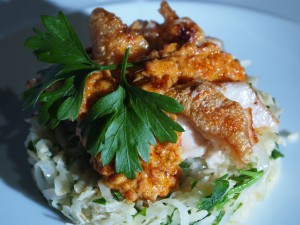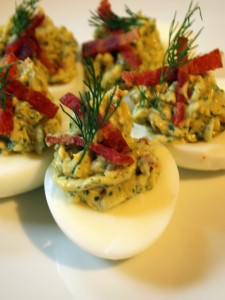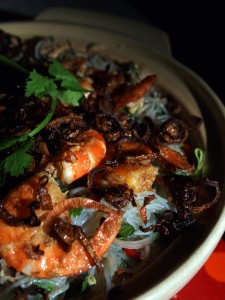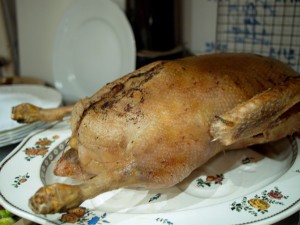
I’ve held off for couple of weeks post-Christmas on this, because I am assuming that today is approximately the day when most of you will be getting sick of your New Year’s resolution to avoid crispy skin, potatoes softened beautifully with goose drippings, and tender forkfuls of breast meat. Everybody else should herewith bookmark this page for Christmas 2011, by which time things festive will no longer cause your gorge to rise.
A goose this large will feed six or more, although you won’t have the great buckets of leftovers that turkeys generate. (All the better, to my mind.) And it turned out superbly; I’m not sure whether this goose or the obscenely juicy brined turkey from Christmas 2008 would win in a fight. Our goose was tender and moist, filled near unto bursting (you can see the straining of the gap where it was sewed shut in the picture) with one of the best stuffings I’ve ever made, all wrapped up in a golden, crispy skin. If you do end up cooking this for a family occasion, you’ll also find yourself the proud possessor of a massive tub of goose fat to pop in the fridge. My Mum suggested turning it into a fatball for the poor starving robins in the snow. I said pshaw, and chilled it in jam jars for future potatoes.
Geese were, of course, the upper-class Christmas comestible of choice in England until being supplanted by the filthy heathen turkey from America, which Dickens did a lot to popularise by putting one on the Cratchit’s table. Medieval swanks would spend a day’s wages on a fat goose (and they are fat, even if not raised for foie – be sure to remove the lumps of poultry fat from the body cavity before you begin cooking, and render them down in a pan over a low heat for the lovely drippings), which they would roast on a spit over a fire, the skin coloured with saffron in butter for a chi-chi golden tone. The goose tradition carried on until Dickens all but killed it with A Christmas Carol. These days, we all have ovens, and you can buy Heston’s gold leaf at Waitrose instead and poke at it gently all over the bird with a soft brush, if your family is the sort that really needs impressing, but I think the skin is perfectly golden enough if you cook it using the method below.
Potato stuffing is the perfect choice for a bird as fatty as a goose. Use a fluffy, floury potato; I chose King Edwards. The potato will soak up the bird’s delicious juices in a way that will astonish you, and takes on flavour from the sage, onion and pancetta it’s mixed with, which flavours also impregnate the flesh of the goose. A couple of sweet eating apples cut into small chunks and stirred into the mixture will collapse on cooking to give the whole stuffing a very gentle background sweetness which is glorious against the rich meat. Buy the best goose you can afford; the way your bird is raised, killed and butchered really does make a difference. We had a beautiful free-range goose, good-smelling even when raw, from Franklin’s Farm, which supplies my parents’ local farmers’ market.
To serve about six people you’ll need:
A goose weighing between 5 and 6kg
1 kg King Edward potatoes
100g pancetta
100g butter
3 onions
2 Granny Smith apples
3 bay leaves
1 teaspoon thyme leaves
Leaves from 1 stalk fresh rosemary
1 large handful (about 25g) sage leaves, chopped finely
1 teaspoon salt
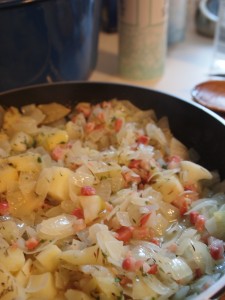
Your goose should start off at room temperature, so make sure it’s out of the fridge for long enough to lose any chill.
Peel the potatoes, chop them into pieces about 1 inch square, and simmer them until soft (about ten minutes from the time they come to the boil if you start them off in cold water). While the potatoes are cooking, peel and core the apples, and chop them into small pieces. Peel and dice the onion.
Melt the butter in a large, heavy frying pan, and saute the onion, apple and pancetta together with the thyme and bay until the onion is soft and sweet, but not coloured (about 8 minutes – see the picture for the sort of texture you’re aiming for). Remove from the heat to a very large mixing bowl with the buttery juices.
When the potatoes are soft, drain them and add them to the mixing bowl with the rosemary, sage and salt. Stir the stuffing mixture well to make sure all the ingredients are blended.
Remove any poultry fat from inside the bird’s cavity – if you’re lucky there should be at least a couple of fist-sized white chunks in there. You can use scissors to snip it into pieces and dry-fry it over a low heat to render it down for a jar of goose fat for the fridge if you like. It goes without saying that you should remove the packet of giblets too – if you want giblet stock, simmer them without the liver (which does not make good stock) in some water. You can use that liver – my Dad and I have a bit of a tradition of chopping it up and cooking it along with some good curry paste in a little bowl sat in some water, covered with some tin foil, then spreading it on toast for Boxing Day breakfast.
Heat the oven to 225ºC.
Spoon all of the stuffing into the bird, and use stout cotton and a thick needle to sew the gap shut. If you can’t face it, you can also use skewers to secure it, but this will be much less neat. Weigh the stuffed bird and put it on a rack in a large baking tray.
Cook the goose at 225ºC for half an hour, then bring the heat down to 180ºC, taking the opportunity to pour off the fat that will have rendered out of the bird in that first hour – save it for spuds. After the initial 30 minutes at 225ºC, cook the goose at 180ºC for 30 minutes per kg stuffed weight, pouring off the fat regularly.
Check that the juices run clear by poking a skewer behind the thigh. The juices should run clear. Rest the goose for ten minutes before carving.

